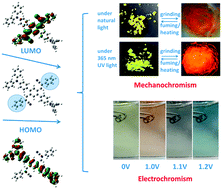Unique torsional cruciform π-architectures composed of donor and acceptor axes exhibiting mechanochromic and electrochromic properties†
Abstract
A series of unprecedented bifunctional materials response to both mechanical and electrical stimuli have been developed with torsional cruciform π-architectures composed of donor and acceptor axes. These cross-conjugated geometries possess spatially separated HOMO and LUMO located on the donor and acceptor axis, respectively. A unique charge transfer (CT) process from one axis to the other in the excited state is evidenced by theoretical calculations and spectral analysis. This unusual electronic nature along with the conformational flexibility of compounds is found to be significant for their effective mechanochromic (MC) and electrochromic (EC) performances. Through changing substituents on one bar, systematic and comparative studies have been carried out to explore the structural impacts on the MC and EC properties. Based on the structure–property relationships, remarkable MC materials with emission shifts above 70 nm and excellent EC materials with high optical contrast (70%) and fast response time (0.59 s for fading, 1.44 s for colouring) are obtained. Besides, an effective method for selectively modulating the LUMO energy level as well as bandgap is also attained.


 Please wait while we load your content...
Please wait while we load your content...